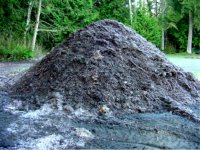GregJ
Platinum Member
- Joined
- Oct 8, 2002
- Messages
- 708
- Location
- Washington
- Tractor
- Kubota B2301/LA435FEL/BH70 ; John Deere X350
When I bought my tractor in September 2002, I purchased a Bearcat chipper/shredder with it. I wanted to be able to create my own compost/mulch to be used around our place for landscaping. I thought I would share what I've learned as I enter my second season of composting. The purpose of my post is to hear what others have learned as well.
1. Pile it high and turn it often. I have found that it packs down and the heat will actually dry out the pile even here in the rainy NW. The oxygen also helps the composting process. Also, the higher the pile, the less surface area there is to be contaminated by weed seed.
2. There is no need for compost bins if you are doing piles. It actually makes it easier to move the piles. When I turn the piles I pick up a little dirt from the bottom and this is actually good for the compost.
3. Make sure that your pile is out in the open and not under a tree. My first year I made my pile under trees and even with record rainfalls, it dried out.
4. Never add shredded paper to your pile. /forums/images/graemlins/crazy.gif This is the BIG one I learned this year. I was reading on a soil/compost forum about adding shredded paper to compost. Last summer, we had a lengthy burn ban and my shredded paper started to pile up. Our local recycle company will not take shredded paper. /forums/images/graemlins/confused.gif So, I thought I'd just mix it into my pile. After 4 months, it hasn't even started to breakdown.
5. The mulch that I have composted for 8-9 months is beautiful, fine and dark. Any less time and it seems that the larger wood chips have not broken down yet.
These are the things that I have learned so far. I have attached a picture of my current pile that I started in August. I hope that others will add to my list of things you have learned about composting.
Greg
1. Pile it high and turn it often. I have found that it packs down and the heat will actually dry out the pile even here in the rainy NW. The oxygen also helps the composting process. Also, the higher the pile, the less surface area there is to be contaminated by weed seed.
2. There is no need for compost bins if you are doing piles. It actually makes it easier to move the piles. When I turn the piles I pick up a little dirt from the bottom and this is actually good for the compost.
3. Make sure that your pile is out in the open and not under a tree. My first year I made my pile under trees and even with record rainfalls, it dried out.
4. Never add shredded paper to your pile. /forums/images/graemlins/crazy.gif This is the BIG one I learned this year. I was reading on a soil/compost forum about adding shredded paper to compost. Last summer, we had a lengthy burn ban and my shredded paper started to pile up. Our local recycle company will not take shredded paper. /forums/images/graemlins/confused.gif So, I thought I'd just mix it into my pile. After 4 months, it hasn't even started to breakdown.
5. The mulch that I have composted for 8-9 months is beautiful, fine and dark. Any less time and it seems that the larger wood chips have not broken down yet.
These are the things that I have learned so far. I have attached a picture of my current pile that I started in August. I hope that others will add to my list of things you have learned about composting.
Greg


